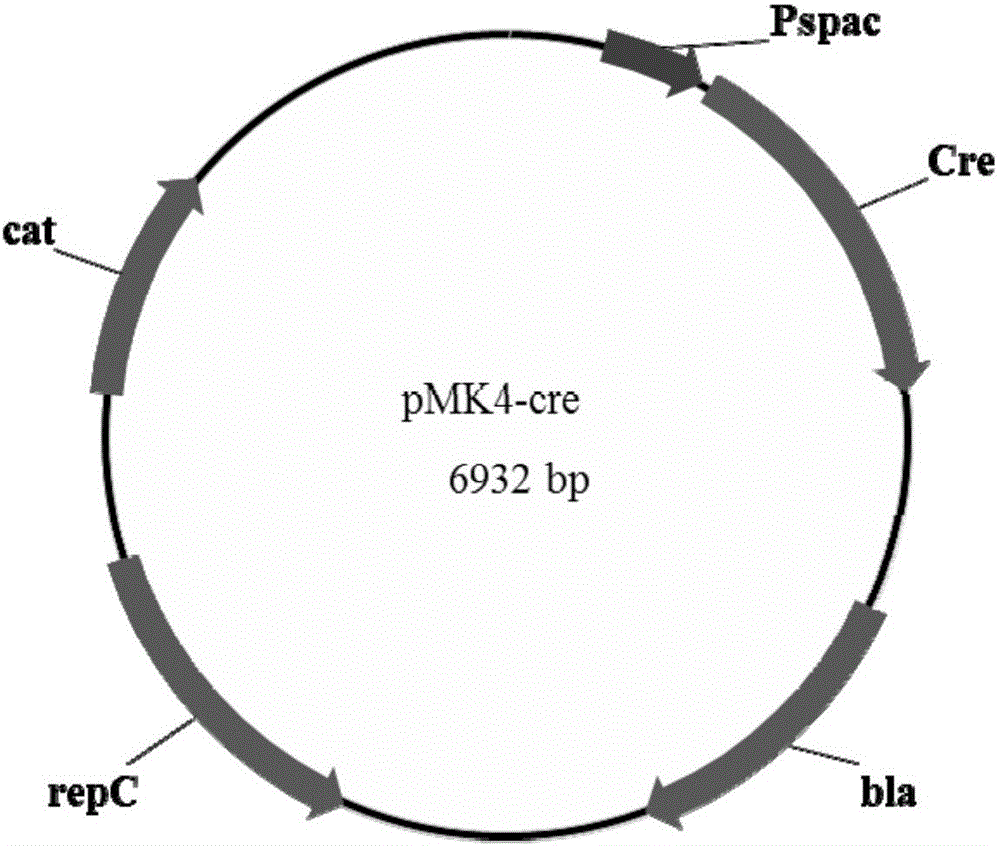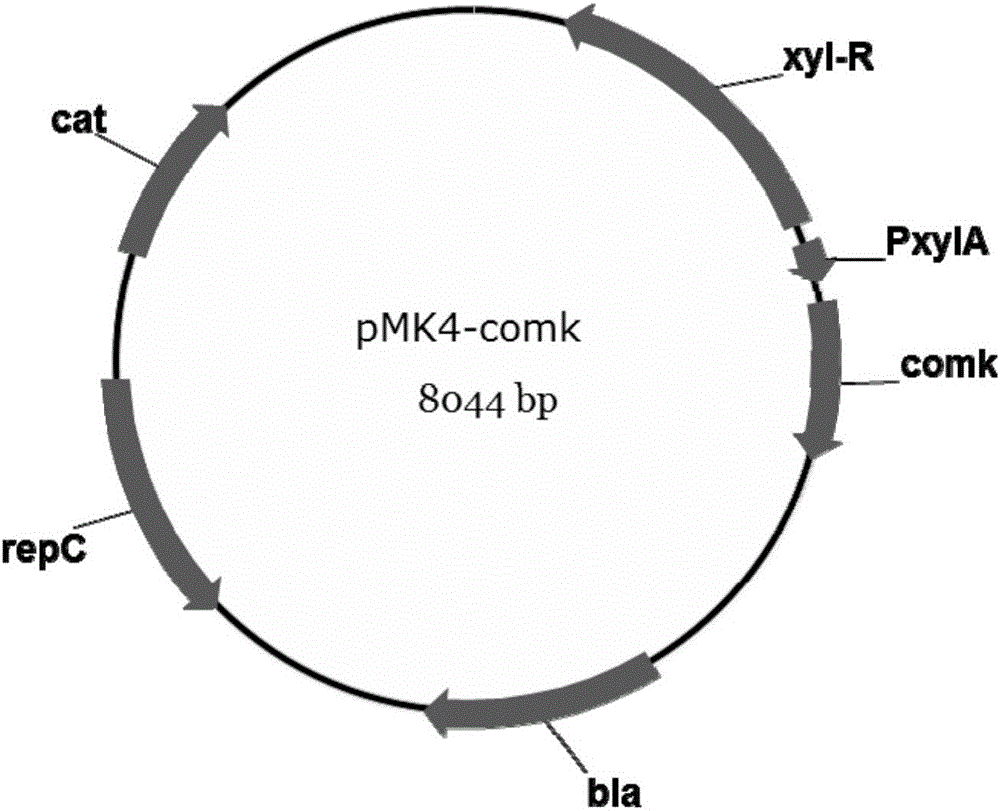High-conversion-rate bacillus subtilis and structuring method thereof
A Bacillus subtilis and gene technology, applied in the field of microorganisms, can solve the problems of low transformation efficiency of wild-type Bacillus subtilis, and achieve the effects of large application potential, easy operation and elimination of resistance.
- Summary
- Abstract
- Description
- Claims
- Application Information
AI Technical Summary
Problems solved by technology
Method used
Image
Examples
Embodiment 1
[0044] Example 1 Construction of expression plasmid pMK4-cre, expression plasmid pMK4-comk and recombinant plasmid pGSNE-nprlR-comk
[0045] 1. Construction of pMK4-cre
[0046] pMK4-cre is based on the pMK4 vector, which is connected with a Cre enzyme expression gene cre containing a Pspac promoter, and is used for expressing Cre enzyme in Bacillus picaridis. The sequence of pMK4-cre is shown in SEQ NO.1, specifically:
[0047]
[0048] The Pspac-cre fragment was amplified by PCR using the plasmid pDGC as a template, using Pcre-F (SEQ ID NO.5) as an upstream primer, and Pcre-R (SEQ ID NO.6) as a downstream primer.
[0049] Pcre-F (SEQ ID NO.5), specifically: taccgaattctacacagcccagtccaga.
[0050] Pcre-R (SEQ ID NO.6), specifically: ctaggaattcgcatgcctaatcgccatcttccag.
[0051] The PCR reaction system is as follows:
[0052]
[0053] Run the following programs on a Mastercycler ordinary PCR machine (Eppendorf):
[0054] (1) 98°C, 2min; (2) 98°C, 15sec; (3) 55°C, 15sec; (...
example 2
[0084] Example 2 Construction of Bacillus subtilis 164S
[0085] Using plasmids pMK4-comk, pGSNE-nprlR-comk, and pMK4-cre to transform Bacillus subtilis A164 (the DDBJ / EMBL / GenBank access number of A164 genome sequence is no.CP011115), and finally obtained an easy-to-operate strain of subtilis with high transformation efficiency Bacillus 164S, see flow chart Figure 4 .
[0086] The specific operation is as follows:
[0087] First, pMK4-comk was transformed into Bacillus subtilis A164. The transformation adopts the method of hyperosmotic electric shock transformation,
[0088] a) inoculate Bacillus subtilis A164 in 3mL LB medium, cultivate overnight;
[0089] b) Transfer 2.6mL of overnight culture solution to 40mL (LB+0.5M sorbitol) and culture at 37°C and 200rpm until OD600=0.8;
[0090] c) Bath the bacterial solution in ice water for 10 minutes, then centrifuge at 5000g for 5 minutes at 4°C to collect the bacterial cells;
[0091] d) Use 30mL pre-cooled electroporation...
example 3
[0107] Example 3 Knockout of Bacillus subtilis 164S amylase gene
[0108] The gene manipulation of Bacillus subtilis 164S can be conveniently carried out by adopting the method of inducing transformation. After using the restriction endonuclease Kpn I to cut the amylase knockout plasmid pDG364, without cleaning the product, directly transform into Bacillus subtilis 164S:
[0109] a) Inoculate the plate-activated Bacillus subtilis 164S colony into a 3mL LB test tube, and incubate at 37°C and 200rpm for 10-12h;
[0110] b) Transfer 300 μL culture solution to a preheated 3 mL LB test tube, add filter-sterilized xylose solution to a final xylose concentration of 1%, and incubate at 37°C and 200 rpm for 3 hours;
[0111] c) Dispense into 2mL Eppendorf tubes, add linearized plasmid at a ratio of 100ng DNA / 100μL culture solution, and incubate at 37°C and 200rpm for 1.5h. Coat the chloramphenicol resistant plate with 5 µg / mL. Incubate overnight at 37°C.
PUM
 Login to View More
Login to View More Abstract
Description
Claims
Application Information
 Login to View More
Login to View More - R&D
- Intellectual Property
- Life Sciences
- Materials
- Tech Scout
- Unparalleled Data Quality
- Higher Quality Content
- 60% Fewer Hallucinations
Browse by: Latest US Patents, China's latest patents, Technical Efficacy Thesaurus, Application Domain, Technology Topic, Popular Technical Reports.
© 2025 PatSnap. All rights reserved.Legal|Privacy policy|Modern Slavery Act Transparency Statement|Sitemap|About US| Contact US: help@patsnap.com



